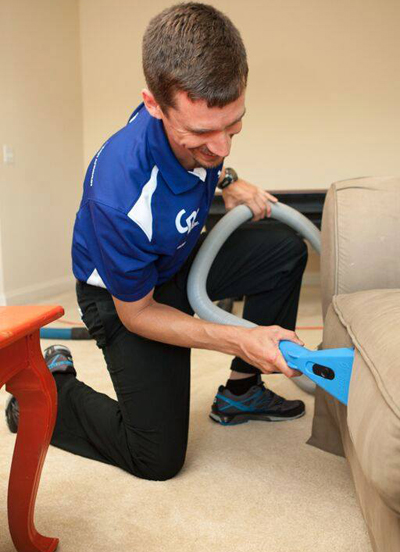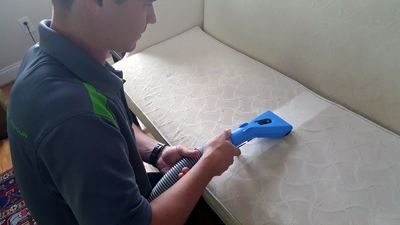Upholstery cleaning makes up a large portion of our business and regardless of age, style or fabric we’re here to help you maintain it. To keep your furniture clean and looking good, it is important to vacuum regularly and schedule periodic cleanings. Furniture and fabric manufacturers recommend that consumers not wait until severe soiling has occurred because the greater the soiling, the less the likelihood of restoring the fabrics original color, appearance and texture. Regular cleaning of your home furnishings by a trained and certified Carpet Pro Cleaners technician can help extend its life and keep it looking new. Our technicians can also offer simple suggestions to maintain a cleaner, safer and healthier home or business environment.
Why Do I Need Upholstery Cleaning For A Healthy Home?

Furniture and other upholstery are a breeding ground for harmful microbes, which can cause allergies, sickness and offensive odors. By design, many furnishings collect and trap dust, providing a perfect environment for mites. Also wool fabrics shed particles that can be eaten by mites and other insects. House dust mites are found in most homes. They are microscopic, eight legged creatures closely associated with us. The primary concern about mites is that some people are allergic to them. Symptoms associated with dust mite allergies include sneezing, watery eyes, nasal stuffiness, runny nose, stuffy ears, respiratory problems, eczema and in severe cases, asthma. These symptoms can be aggravated by stirring up dust but it’s important to know that dust often contains other allergens, including pet dander, cockroach droppings, mold spores and pollen. Dust will often accumulate in crevices of cushions, behind and underneath home furnishings. To learn more about dust mites click here.
Dust Mites
There are two species of house dust mites found in North America. These mites are so small they are virtually invisible without magnification. Female mites lay cream-colored eggs coated with a sticky substance so eggs will cling to the substrate. These mites have two distinct immature stages. Under optimal conditions, the entire life cycle from egg to adult takes three-four weeks. House dust mites feed on human skin scales, pollen, fungi, bacteria and animal dander. Dust mites do not drink free water, but absorb water from the air and the environment. To thrive, dust mites need very warm temperatures (75-80 degrees F) and high humidity levels — 70-80 percent relative humidity. One study showed when humidity is 60 percent or lower, the mite population stops growing and dies out.
Humans continually shed skin and lose about 1/5 ounce of dead skin each week. We also spend about one-third of our lives sleeping so high levels of dust mites are often associated with the bedroom, especially bedding and the mattress. Dust mites also eat animal dander so allergens will be plentiful in areas where family pets sleep.
The house dust mite (sometimes referred to by allergists as HDM) is a cosmopolitan guest in human habitation. Dust mites feed on organic detritus such as flakes of shed human skin and flourish in the stable environment of dwellings. House dust mites are a common cause of asthma and allergic symptoms worldwide. The mite’s gut contains potent digestive enzymes (notably proteases) that persist in their feces and are major inducers of allergic reactions such as wheezing. The mite’s exoskeleton can also contribute to allergic reactions. The European house dust mite (Dermatophagoides pteronyssinus) and the American house dust mite (Dermatophagoides farinae) are two different species, but are not necessarily confined to Europe or North America; a third species Euroglyphus maynei also occurs widely.
Description
The body of a house dust mite is just visible against a dark background in normal light. A typical house dust mite measures 0.4 millimetres (0.016 in) in length and 0.25–0.32 millimetre (0.010–0.013 in) in width.[1] For accurate identification, one needs at least 10× magnification. The body of the house dust mite has a striated cuticle. Like all acari, house dust mites have eight legs (except the first instar, which has six).
Life cycle
The average life cycle for a male house dust mite is 10 to 19 days. A mated female house dust mite can last up to 70 days, laying 60 to 100 eggs in the last 5 weeks of her life. In a 10-week life span, a house dust mite will produce approximately 2,000 fecal particles and an even larger number of partially digested enzyme-covered dust particles.
Habitat and food
The house dust mite survives in all climates, even at high altitude. House dust mites thrive in the indoor environment provided by homes, specifically in bedrooms and kitchens. Dust mites survive well in mattresses, carpets, furniture and bedding, with figures around 100–500 animals/g dust.[3] Even in dry climates, house dust mites survive and reproduce easily in bedding (especially in pillows), which takes up moisture from body contact.[4]
House dust mites consume minute particles of organic matter. Like all acari, house dust mites have a simple gut; they have no stomach but rather diverticulae, which are sacs or pouches that divert out of hollow organs. Like many decomposer animals, they select food that has been already partially decomposed by fungi.
Asthma and allergies
Allergens produced by house dust mites are among the most common triggers of asthma. There are at least 15 mite allergens which are subdivided into groups. Group 1 and 2 allergens are the most problematic. Group 1 consists of proteins with a catalytic activity, for example Der p 1 (Dermatophagoides pteronyssinus group 1) allergen is a cysteine protease, as is its American counterpart Der f 1 (Dermatophagoides farinae group 1). Group 2 are proteins important for the mite. Proteins from the other groups affect only few patients. Studies have shown the mean attributable fraction of adult asthma due to atopic sensitization was 30% and 18% for sensitization to dust mites.[5] Taken into consideration this could mean as many as 1.2 billion people could have some form of chronic sensitization to dust mites.
The allergy occurs because the immune system of allergy affected individuals, for reasons not fully understood, misinterprets a usually innocuous substance as a disease agent and begins producing a type of antibody against it, called immunoglobulin E (IgE).[6] This is called the ‘primary antibody response.’ The IgE produced during this response binds to basophils in the bloodstream and to a similar type of cell called mast cells in the tissues. When the person again encounters the allergen, these basophils and mast cells that have bound to IgE release histamine, prostaglandins and leukotrienes, which causes inflammation of the surrounding tissues, resulting in allergic symptoms. Most treatment has relied so far on trying to counteract the released chemicals with anti-histamines, corticosteroids or Salbutamol. Commercial brands of these medications most commonly prescribed to treat Asthma include Ventolin and Seretide.
Newer methods to try to treat house dust mite allergy involve immunotherapy. A safety and tolerability clinical trial (Phase IIa) has been completed with positive results by Cytos Biotechnology using an immunotherapeutic (CYT003-QbG10) for treatment of house dust mite-triggered allergies.
A 10 year controlled study in 60 mite sensitised, asthmatic children, showed almost complete remission of asthma in those treated with sublingual immunotherapy (SLIT), and that this remission was still apparent 5 years beyond the completion of treatment.
This finding was supported by a review of 39 mite triggered asthmatic children, who were suffering an average of 8 acute exacerbations per year. After treatment with SLIT, the exacerbation rate was reduced by 95%.
The French biopharmaceutical company Stallergenes is developing, via the Stalair Program, sublingual desensitization treatments for house dust mite allergy. The immunotherapy tablet, “Actair”, has demonstrated efficacy after 4 months of treatment and the persistence of its therapeutic effect after only one year of treatment. (study VO57.07 conducted in Europe) Stallergenes is now preparing filing NDA in Germany. A phase III pediatric study has been launched.
Typical symptoms of house dust mite allergies are itchiness; sneezing; inflamed or infected eczema skin; watering/reddening eye; sneezing repeatedly and frequently, e.g., on waking up or sneezing 10 or more times; runny nose; and clogging in the lungs.
Dust mite immunotherapy is still not widespread, especially in countries such the UK. If allergic asthmatic children cannot get access to desensitisation, then the best form of treatment for dust mite allergies remains one of avoidance, although this requires a high level of commitment from patient/parents. It is important however, to maintain use of medication such as anti-histamines, corticosteroids or Salbutamol. The environment of bedding is optimal for most dust mites, and comparative studies have shown that the density of dust mites in mattresses is on average greater than 2500/gram of dust.[10] Cleaning beds with most vacuum cleaners will not remove dust mite allergens, but instead throw them into the air and increase their volatility. Some polyethylene bedding is beneficial as it makes the environment difficult for the dust mites. This bedding should also be breathable and be able to withstand frequent washing. A home allergen reduction plan has been recognized as being an essential part to the management of asthma symptoms,[11] and therefore all aspects of the home environment should be considered (proper vacuuming, use of air cleaners, etc.). The Asthma and Allergy Foundation of America as well as the Asthma Society of Canada certify products that may be used in a home allergen reduction plan in a Program called Asthma and Allergy Friendly.
Common beliefs and misconceptions
It is commonly believed that the accumulated detritus from dust mites can add significantly to the weight of mattresses and pillows. While some recent studies have supported this claim,[12] other reports dispute it.[13] However, more scientific evidence is needed for a complete consensus.
Allergy and asthma sufferers are also often advised to avoid feather pillows due to the presumed increased presence of the house dust mite allergen (Der p I). The reverse, however, is true. A 1996 study from the British Medical Journal has shown that polyester fibre pillows contained more than 8 times the total weight of Der p I and 3.57 times more micrograms of Der p I per gram of fine dust than feather pillows.
Eradication
House dust mites reproduce quickly enough that their effect on human health can be significant. Since dust mites depend on moisture to survive, they are most often found in bedding such as pillows and duvets.[1] Dust mites numbers can be reduced by replacing carpets with flat surfaces that are easier to vacuum and maintaining relative humidity below 50%.[15] Existing mites can be eradicated by regularly cleaning and washing items that harbour them, exposing them to temperatures over 60 °C (140 °F) for a period of one hour or to temperatures below 0 °C (32 °F),[16][citation needed] through ten minutes’ exposure to the lethal temperatures – near 105 °C (221 °F) – in a household clothes dryer,[17] or using disodium octaborate tetrahydrate (DOT) powder.[18] A side-effect of DOT is irritation of eyes.
How can CPC help?

Upholstery cleaning is detailed work. Carpet Pro Cleaners has the knowledge and experience to deal with all types of fabric. We use non-toxic cleaning agents to clean upholstery that are safe on fabrics and eliminate odor through cleaning not masking. We apply this solution to the upholstery via low-pressure spray, loosening embedded dirt, scrubbing when necessary, cleaning the material, and removing a wide range of germs, mites, dust and bacteria. The emulsified dirt is then disposed washed away by our extremely hot, ionized water system and carried out to the van via high-powered truck mounted equipment.
There are several advantages of using the Carpet Pro Cleaners system to clean your furniture and upholstery. The system is safe on all kinds of upholstery, including the finest natural fibers and the hardiest synthetics. There is no exposure to harmful cleaning agents that fill the air with some other cleaners. It’s great for sofas, dining chairs, auto interiors, or any upholstered item!
FAQs
How clean can I expect my old chair to be after CPC cleaning?
Upon arrival, our specialist will inspect the age and the condition of the fabric, its maintenance history, and the type and amount of soil present. Then, based on their professional judgment and costumer concern, we set the expectation at the level the fabric can be cleaned
How long will it take my upholstery to dry?
Dry times are typically similar to that of carpet. Like carpet, dry times are dependent upon a few variables including but not limited to soil level, air conditions and humidity, air circulation in the home and style and thickness of fabric. Dry time is usually 6-8 hours.
The tag on my upholstery says “Dry Clean Only.” Can you still clean it?
This type of label is frequently found on different types of upholstery to free the manufacturer of any liability for problems that may occur during the cleaning process. On occasion, there are some delicate or natural upholstery fabrics that should not be cleaned with the hot water extraction method. A CPC trained technician will be glad to make an assessment and set the proper expectation in advance.
How often should I have my upholstery cleaned?
Especially when upholstery is receiving frequent or daily use, soil and dust can accumulate quickly. Carpet Pro Cleaners recommends annual or bi-annual cleaning depending upon a few factors including, frequency of use by family member and pets and durability of the fabric.

